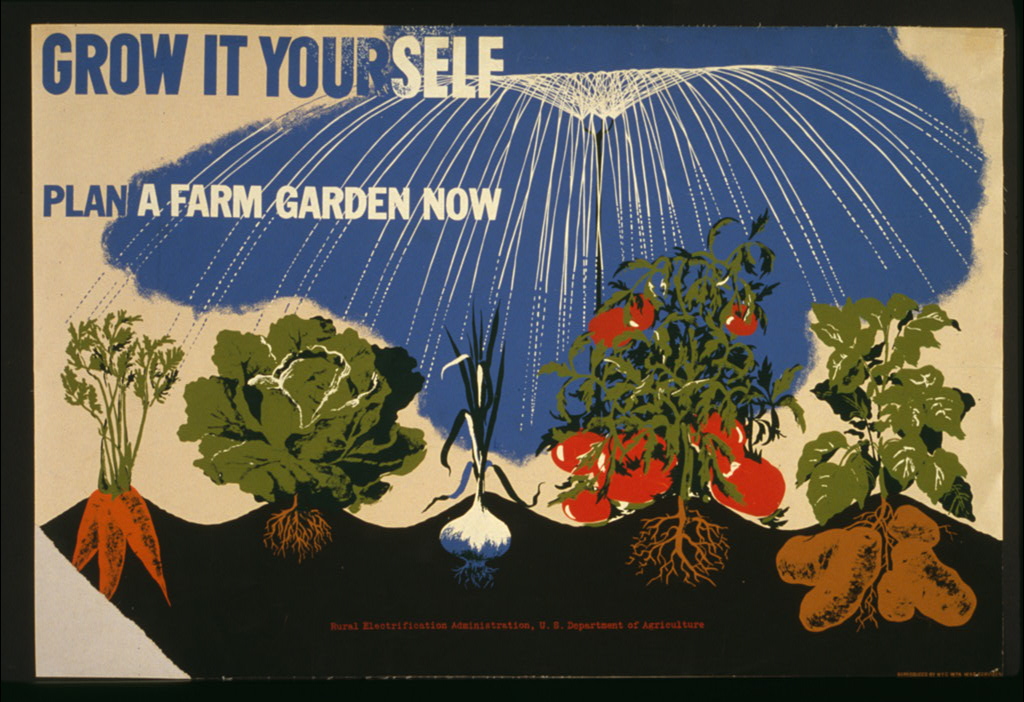A reversal of priorities: packaging
GDES-270 fall 2020 (David Ramos, American University Design)
ramos@american.edu · office hours

Poster by Herbert Bayer for NYC WPA War Services, between 1941 and 1943.
In the First Things First 2000 manifesto, designers call for a reversal of priorities, arguing that the profession has a role in meeting “environmental, social, and cultural crises.” That idea is just as true now—see, for instance, Lucienne Roberts, What Role Does Design Play in a Public Health Crisis?. In this project, we’ll explore how you could redesign a package to balance a number of needs.
We’ll consider business and marketing concerns—the product needs to move! Supply chains matter, since the package has to get from its point of origin to a customer. We’ll also want to design for that customer’s experience, and think about the customer’s relationship with the product. In a world of finite ecological boundaries, we’ll need to think about sustainability: what demands we place on resources, the package’s recyclability/reusability, and the life cycle of the materials we use. We should also consider the culture and society that this package helps create.
Guiding principles
You might look to a few sources for advice:
- Hannover Principles, created by William McDonough Architects and Dr. Michael Braungart
- Design Strategies: Paper & Packaging (concise) at renourish, a project started by Eric Benson and Yvette Perullo
- Re-ourish Sustainable Standards: Print (more detailed)
Phases of work
For deadlines, see course schedule.
Part 1: Finding and evaluating two packages
Look around your space, and start noticing product packaging. Find two packages that you might want to redesign. Choose items that you have on hand—you need to be able to feel their size and weight, understand materials, and examine the relationship between the contents and the container.
Assess each of these packages. Think about:
- Why someone designed the package this way
- The customer’s experience
- Ease of use
- Environmental performance (like carbon footprint, reusability, and recyclability)
- Logistical and operational issues (can warehouse employees handle the package? does the object fall over?)
- Who’s choosing and using the product
- Alignment with branding and marketing strategy
- Your own relationship with the product/package
Create a series of text/image boards that explain your thoughts about both of these two packages. (Boards are like slides, but you won’t be presenting them as a slide show. See pages 37, 51, 87, 134, 135, and 145 in Design is Storytelling for ideas.) Post these boards on Miro.
Part 2: Initial sketches and material samples
Come up with two ideas for how you might approach the redesign. Share these ideas in sketch form. You might show us perspective views, or a section (from the side), or a diagram that explodes the package into its component pieces. Add labels and explanatory text to these sketches.
Think, also, about the materials you’ll use. If you can, find samples of the materials, as scraps, from art supply stores, or by taking apart other packages. If you can’t find a material in physical form, find images for materials online. Share photos of your materials with us, as well.
Post boards to Miro.
Part 3: Refined sketches
Based on comments from critique, improve on the previous week’s ideas. Make new boards and new material samples and post on Miro.
You should probably settle on one idea—either one of the two from last week, or a hybrid, or something entirely new (if things have gone badly wrong, but they probably haven’t).
Part 4: Initial prototype
Continue iterating on your idea. This week, also produce a rough prototype of your package. This should be a physical object that you can hold. Build it at full size. Use materials that come close to the real product.
Post new material to Miro, along with photos of the prototype.
Part 5: Final versions
Put together final boards that explain your idea, and assemble a more polished prototype.
Post to Miro for critique.
Final deliverables
Turn in a folder containing PDF or JPG files, with your work for each week, plus the final versions. (Please label the files with weeks or dates, or group them in subfolders.)
Evaluation
I’ll evaluate this project based in part on the thoroughness of your research and analysis, how you apply design to the task of making a new package, and on how you explain that design to us with documentation and a prototype. Process, developing and improving a design through iteration, always counts, so do show your work in critiques and in the final deliverables.